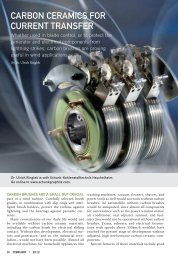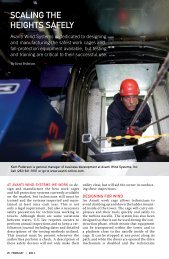download pdf - Wind Systems Magazine
download pdf - Wind Systems Magazine
download pdf - Wind Systems Magazine
You also want an ePaper? Increase the reach of your titles
YUMPU automatically turns print PDFs into web optimized ePapers that Google loves.
main target of SOME-ECO is to make accurate<br />
long-term noise predictions in a particular environment<br />
with certain characteristics. For this purpose,<br />
SOME-ECO attempts to correlate external<br />
background noise with meteorological variables<br />
such as temperature, wind speed and relative humidity.<br />
Unlike current background noise measurement<br />
regulations, which do not comprehensively<br />
take into consideration the effect of these factors,<br />
SOME-ECO takes them into account in its calculations.<br />
Then, by knowing the influence of these variables<br />
and quantifying the correlation of short-term<br />
levels of background noise with their equivalent<br />
long-term values, SOME-ECO attempts to be able<br />
to make noise predictions based on these factors.<br />
One of the most frequent choices to date is to<br />
define large safety margins in the prediction of<br />
background noise to account for its possible variations<br />
over time. However, this methodology is often<br />
inefficient and prevents the optimization of<br />
the financial return of the wind farm initial investment.<br />
Since current regulations do not specify the<br />
duration of the background noise measurements,<br />
they are usually carried out over short periods of<br />
time between 2 and 7 days. These short-time measurements<br />
prove to be insufficient and large safety<br />
margins are defined, instead of making accurate<br />
noise predictions based on the characteristics and<br />
the meteorological variables that influence the<br />
wind farm location.<br />
SOME-ECO is reformulating the current methods<br />
for predicting external background noise and<br />
provides, for the first time, representative information<br />
that guarantees more realistic forecasts of<br />
background noise from representative variables of<br />
the site. The project seeks to optimize the installed<br />
power and the operating strategies of a wind farm.<br />
To do so, this study has two main phases to follow<br />
up: a first step that consists of generating a model<br />
by correlating external background noise with<br />
meteorological variables and a second step which<br />
is the noise prediction itself, from the generated<br />
model and short-time measurements of the studied<br />
location.<br />
CREATiNg A MODEl: CORRElATiON OF ThE<br />
bACKgROUND NOiSE WiTh METEOROlOgi-<br />
CAl VARiAblES.<br />
The first objective of SOME-ECO is to create a<br />
model by correlating background noise with climatic<br />
variables that are specific to a particular place<br />
for a period of one year. The purpose is to provide<br />
accurate and representative data on the contribution<br />
of meteorological variables to external background<br />
noise at different periods of the year and at locations<br />
with different characteristics.<br />
To do so, ICR will analyze the behavior of atmospheric<br />
pressure, temperature, wind speed, wind direction<br />
and relative humidity among other things in<br />
five different representative areas of measurement.<br />
The 5 chosen locations are 2 urban areas and 3 rural<br />
areas. This work procedure allows to learn about the<br />
evolution over time of every variable separately and<br />
to study how they contribute jointly to external background<br />
noise by means of multidimensional data<br />
analysis. As a result, different models are obtained<br />
depending on the studied location (Figure 1). Other<br />
variables, such as the day of the week, the period of<br />
the year, may be included as well in the model.<br />
As shown in figure 2, a seven-day evolution of<br />
four variables (rain, temperature, wind speed and<br />
windsystemsmag.com 31




